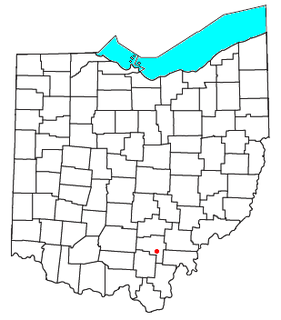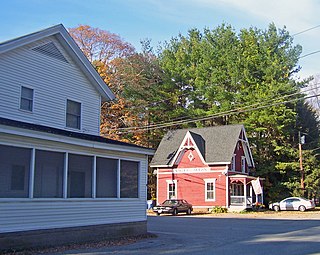
Hydeville is a rural section of the town of Stafford, Connecticut, located on Furnace Creek. Historically it was also known as Haydenville. [1]

Hydeville is a rural section of the town of Stafford, Connecticut, located on Furnace Creek. Historically it was also known as Haydenville. [1]
The Lafayette blast furnace, established in Hydeville in 1799 to process bog iron, is reputed to have been the first iron furnace in the state to cast stoves. It operated until 1840, when the local ore supply had been used up. [2]
In the 1890s, Hydeville was described as "consisting of a few houses about a woolen mill" with a population of about 130. Several of the houses in the village were tenement buildings containing several individual dwelling units. [1]
Wilson Woodworks, a producer of wood flooring, was once located in Hydeville, but moved to the town of Windsor, about 30 miles to the southwest. [3]

Tolland County is a county in the northeastern part of the U.S. state of Connecticut. As of the 2010 census, its population was 152,691. It is incorporated into 13 towns and was originally formed on 13 October 1785 from portions of eastern Hartford County, Connecticut and western Windham County, Connecticut.

Southington is a town in Hartford County, Connecticut, United States. As of the 2010 United States Census, it had a population of 43,069. Southington contains the villages of Marion, Milldale, and Plantsville.

Salisbury is a town in Litchfield County, Connecticut, United States. The town is the northwesternmost in the state of Connecticut; the Massachusetts-New York-Connecticut tri-state marker is located at the northwest corner of the town. The population was 3,741 at the 2010 census.

Stafford is a town in Tolland County, Connecticut, United States, settled in 1719. The population was estimated at 11,893 in 2019. The community consists of the downtown area of Stafford Springs and the more rural villages of Crystal Lake, Ellithorpe, Hydeville, Orcuttsville, Staffordville, Stafford Hollow, Village Hill, and West Stafford. The town most likely derives its name from Staffordshire, in England.

Hopkinton is a town in Washington County, Rhode Island. The population was 8,188 at the 2010 census.

The Connecticut Colony or Colony of Connecticut, originally known as the Connecticut River Colony or simply the River Colony, was an English colony in New England which became the state of Connecticut. It was organized on March 3, 1636 as a settlement for a Puritan congregation, and the English permanently gained control of the region in 1637 after struggles with the Dutch. The colony was later the scene of a bloody war between the colonists and Pequot Indians known as the Pequot War. Connecticut Colony played a significant role in the establishment of self-government in the New World with its refusal to surrender local authority to the Dominion of New England, an event known as the Charter Oak incident which occurred at Jeremy Adams' inn and tavern.

Fort Griswold is a former American defensive fortification in Groton, Connecticut named after Deputy Governor Matthew Griswold. The fort played a key role in the early stages of the American Revolutionary War, in correspondence with Fort Trumbull on the opposite side of the Thames River. Griswold defended the port of New London, Connecticut, a supply center for the Continental Army and friendly port for Connecticut-sanctioned privateers who attacked British ships. The 17-acre site is maintained as Fort Griswold Battlefield State Park by the Connecticut Department of Energy and Environmental Protection.

Connecticut's 2nd congressional district is a congressional district in the U.S. state of Connecticut. Located in the eastern part of the state, the district includes all of New London County, Tolland County, and Windham County, along with parts of Hartford, Middlesex, and New Haven counties.
Asnuntuck Community College (ACC) is a public community college in Enfield, Connecticut. It offers associate degree and certificate programs as well as healthcare certificate programs and business and industry programming.
Shenandoah Valley Railroad was a line completed on June 19, 1882, extending down the Shenandoah Valley from Hagerstown, Maryland through the West Virginia panhandle into Virginia to reach Roanoke, Virginia and to connect with the Norfolk and Western Railway (N&W). The development of this railroad had considerable backing from the Pennsylvania Railroad. In September 1890 it went into bankruptcy and was reorganized as the Shenandoah Valley Railway. In December 1890, it became part of N&W. Today the tracks are a major artery of the Norfolk Southern system.

The Stewart B. McKinney National Wildlife Refuge is a 950-acre (384.5 ha) National Wildlife Refuge in ten units across the U.S. state of Connecticut. Located in the Atlantic Flyway, the refuge spans 70 miles (110 km) of Connecticut coastline and provides important resting, feeding, and nesting habitat for many species of wading birds, shorebirds, songbirds and terns, including the endangered roseate tern. Adjacent waters serve as wintering habitat for brant, scoters, American black duck, and other waterfowl. Overall, the refuge encompasses over 900 acres (364.2 ha) of barrier beach, intertidal wetland and fragile island habitats.

Tahawus was a village in the Town of Newcomb, Essex County, New York, United States. It is now a ghost town situated in the Adirondack Park. Tahawus is located in Essex County within the unpopulated northern area designated to the town of Newcomb. Tahawus was the site of major mining and iron smelting operations in the 19th century. Although standing as recently as 2005, the last mining facilities have since been demolished and removed.

The Scantic River is a river that flows through the states of Massachusetts and Connecticut and is tributary to the Connecticut River.

The Five Mile River is a 10.1-mile-long (16.3 km) river in central Massachusetts, part of the Chicopee River watershed. It rises north of Dean Pond in the Town of Oakham within Rutland State Forest and flows south through Dean Pond to Brooks Pond, 2.5 miles (4.0 km) northeast of North Brookfield, then continues south to its mouth at the north end of Lake Lashaway, also in North Brookfield.

Oreton is a ghost town in eastern Vinton Township, Vinton County, Ohio, United States, located along State Route 160. Oreton was a small mining community. Today, all that remains are the crumbled ruins of the iron furnace, a few concrete foundations, and the brick safe of Dave Ebert's company store.

Stafford Hollow, also known as Stafford, Stafford Village, or Furnace Hollow, is a village in the town of Stafford, in Tolland County, Connecticut, located at the junction of Route 19 and Route 319. Stafford Hollow was the town center of Stafford during the 18th and 19th centuries, before the growth of the village of Stafford Springs.

The Sharon Valley Historic District is located around the junction of Kings Hill, Sharon Valley and Sharon Station roads in Sharon, Connecticut, United States. It is a small community that grew up around an iron mining and refining operation during the late 19th century, the first industry in Sharon.
The Ghost Town Trail is a rail trail in Western Pennsylvania that stretches 36 miles (58 km) from Black Lick, Indiana County, to Ebensburg, Cambria County. Established in 1991 on the right-of-way of the former Ebensburg and Black Lick Railroad, the trail follows the Blacklick Creek and passes through many ghost towns that were abandoned in the early 1900s with the decline of the local coal mining industry. Open year-round to cycling, hiking, and cross-country skiing, the trail is designated as a National Recreation Trail by the United States Department of the Interior.

Old Furnace State Park is a public recreation area adjacent to Ross Pond State Park in the town of Killingly, Connecticut. The state parks covers 367 acres (149 ha), sits at an elevation of 390 feet (120 m), and is open year-round for hiking, hunting, and fishing. It is located east of Interstate 395, south of U.S. Route 6 and north of Connecticut Route 695. The park is the site of a former iron furnace. It was established as a town park in 1909 before being transferred to the state in 1918.